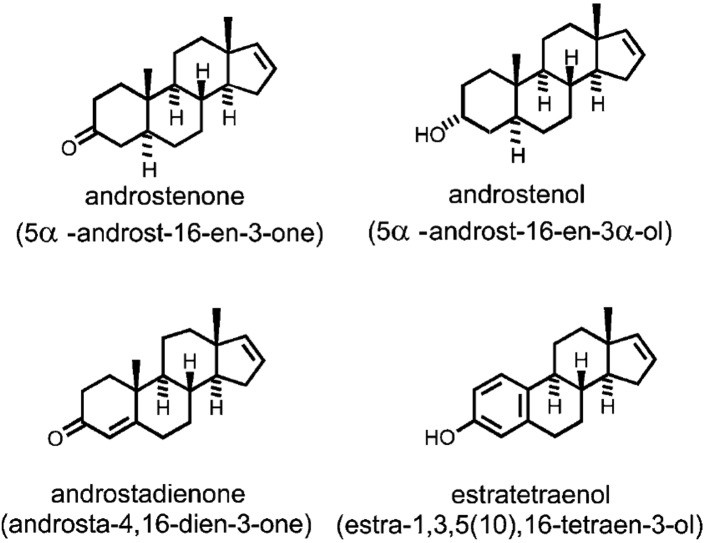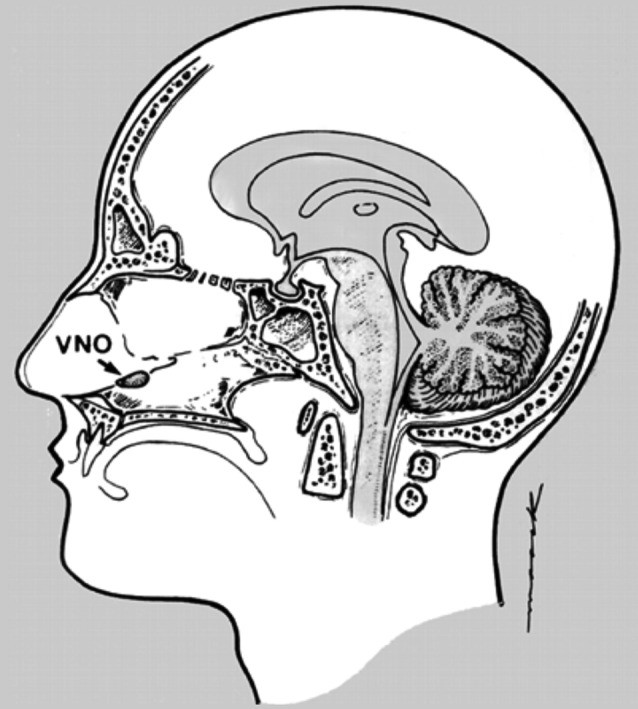Pheromones are fascinating chemical substances produced and released by an animal that can affect the behavior or physiology of other animals of the same species. While well-documented in the animal kingdom, the role of pheromones in humans is a topic of ongoing scientific debate. Historically, it was believed that humans lacked a functional vomeronasal organ (VNO), the specialized pheromone-detecting organ found in many animals. However, research suggests that humans might be more attuned to these subtle chemical signals than previously thought, primarily through our olfactory system. This article delves into the science of pheromones, exploring their definition, types, potential effects in humans, and the key research areas in this intriguing field.
Defining Pheromones: Chemical Messengers
Coined in 1959, the term “pheromone” describes substances secreted externally by an individual and detected by another of the same species, triggering a specific reaction. This reaction can manifest as a behavioral change, a physiological response, or even a developmental process. Think of pheromones as subtle, often odorless (to humans consciously) chemical messages passed between individuals, influencing interactions and even biological functions.
Types of Pheromones: A Classification
Pheromones aren’t a monolithic group; they are categorized based on their effects. Understanding these categories helps clarify the diverse roles pheromones play, particularly when considering their potential functions in humans.
| Name | Effect | Example (Animal) | Potential Human Relevance |
|---|---|---|---|
| Releaser | Immediate, specific behavioral response | Boar androstenone inducing mating posture in sows | Hypothetically, triggering immediate attraction or behavioral changes in social contexts |
| Signaler | Convey information about an individual (identity, status, etc.) | Ants using pheromones to mark trails or identify colony members | Body odor providing cues about identity, genetic compatibility, or emotional state |
| Modulator | Affect mood, emotion, or physiological state over time | Pheromones in rodent urine affecting stress levels in other rodents | Potential impact on human mood, focus, or physiological arousal |
| Primer | Long-term effects on endocrine or reproductive systems | Pheromones influencing puberty onset in mice | Possible influence on menstrual cycles or hormonal responses in humans |


It’s important to note that these categories can overlap, and a single pheromone might have multiple effects. In human research, “modulator” pheromones, those influencing mood and emotion, have received the most attention.
Human Pheromones: Focus on Androstadienone
While pheromones could theoretically be present in various bodily secretions like urine, semen, saliva, and breast milk, research in humans has predominantly focused on axillary sweat – sweat from the armpits. This area is rich in eccrine and apocrine sweat glands, as well as sebaceous glands. While initially odorless, apocrine sweat develops a characteristic scent after interacting with skin bacteria. Factors like clothing, temperature, and air movement influence the dispersal of these odors.
Within axillary sweat, steroid-based compounds known as 16-androstenes have emerged as potential human pheromones. Key among these are:
- Androstadienone (4,16-androstadien-3-one): Considered the most studied and potentially impactful human pheromone, particularly for women.
- Androstenone (5α-androst-16-en-3α-one): Known to elicit mating behavior in pigs.
- Androstenol (5α-androst-16-en-3-ol): Another 16-androstene steroid.
Fig. 1. Chemical structures of key putative human pheromones including androstenone, androstenol, androstadienone, and estratetraenol, highlighting their structural similarities and potential roles as human chemosignals.
Of these, androstadienone stands out due to its more pronounced effects, particularly on women. Interestingly, men produce significantly higher concentrations of 16-androstenes in their sweat compared to women, possibly due to hormonal differences and variations in skin bacteria. While these compounds are present in smaller amounts than other sweat components like organic acids, their volatility and sensitivity thresholds are crucial factors in their potential pheromonal action. Women generally exhibit greater sensitivity to androstadienone, with some individuals identified as “super-smellers” possessing particularly heightened detection abilities.
Another compound of interest is estratetraenol (estra-1,3,5(10),16-tetraen-3-ol), primarily found in women’s urine and likely present in other secretions. While generally exhibiting milder effects than androstadienone, estratetraenol often shows similar trends in its influence on mood and behavior.
The Vomeronasal Organ (VNO): A Human Vestige?
In many animals, pheromones are detected by the VNO, a specialized sensory organ located in the nasal cavity. The VNO sends signals to the accessory olfactory bulb, a distinct brain region from the main olfactory bulb responsible for conscious odor perception.
Fig. 2. Illustration of the purported human vomeronasal organ (VNO), noting the scientific consensus that it is non-functional in adult humans, despite its presence in fetal development. Image adapted from Monti-Bloch et al., 1998, depicting the historical perspective on human VNO.
Human fetuses possess a VNO with typical structural features. However, by adulthood, evidence suggests it becomes non-functional. Genes associated with VNO receptor proteins are inactive, receptor cells are undetectable, and the accessory olfactory bulb is absent. Intriguingly, neurons crucial for puberty and reproduction (GnRH neurons) migrate from the fetal VNO region to the brain, effectively replacing the degenerating VNO nerves.
However, the lack of a functional VNO in adult humans doesn’t negate the possibility of pheromone perception. Some animal pheromones are detected through the regular olfactory system. For example, pigs respond to boar androstenone even when their VNO is blocked. Human olfaction, though often consciously underutilized, is highly capable. Studies have even shown that pheromone detection, specifically for androstenone, can improve with practice, suggesting a degree of olfactory learning and adaptation.
Furthermore, the observation that pheromones applied to the skin can elicit physiological responses suggests a potential mechanism of transdermal absorption, adding another layer of complexity to pheromone detection beyond nasal pathways.
Pheromone Effects: Mood, Focus, and Sexual Response in Women
Research exploring the effects of pheromones, particularly androstadienone, on women has revealed intriguing findings, primarily focusing on mood, attention, and sexual responses.
Several studies have indicated that exposure to androstadienone, or male axillary extracts containing it, can lead to:
- Improved Mood: Women reported experiencing more positive moods and reduced negative moods after exposure to androstadienone. This mood elevation appears dose-dependent and can be influenced by pre-existing emotional states.
- Enhanced Focus: Androstadienone exposure has been linked to increased feelings of focus and attention. This heightened focus might be particularly directed towards processing emotional information.
These mood and focus enhancements are potentially relevant to female sexuality. Positive mood and heightened focus are known to facilitate sexual arousal and satisfaction in women. Studies have shown that androstadienone (and to a lesser extent estratetraenol) can enhance sexual arousal in response to erotic stimuli. Additionally, longer-term exposure to substances from breastfeeding mothers (potentially containing pheromones) has been associated with increased sexual desire and fantasies in women.
Physiological changes consistent with increased arousal have also been observed. Androstadienone can activate the sympathetic nervous system in women, leading to effects like decreased hand palm temperature and increased skin conductance, indicative of physiological arousal. Some studies have also reported elevated salivary cortisol levels after androstadienone exposure, possibly reflecting a stress response or heightened alertness.
Brain imaging studies exploring the neural pathways of pheromone processing have yielded somewhat inconsistent results, and the specific brain regions activated by androstadienone require further clarification. Preliminary findings suggest potential differences in brain processing of androstadienone and estratetraenol between heterosexual and lesbian women, hinting at complex interactions with sexual orientation.
Context plays a crucial role in pheromone effects. The positive effects of androstadienone on mood and physiological responses have been shown to be dependent on the gender of the experimenter, being more pronounced in the presence of a male experimenter. This suggests that the perceived social context can modulate how pheromones are interpreted and their resulting effects. However, more recent research indicates that androstadienone can also enhance attention to emotional cues even in less controlled social settings.
In summary, research suggests that androstadienone, applied typically to the upper lip in studies, may positively influence mood and focus in women, particularly towards emotional information. However, these effects are sensitive to the experimental and social context, highlighting the complex interplay between chemical signals and social cues.
Pheromones and Mate Selection: A Chemical Signature?
Beyond mood and arousal, pheromones may play a role in human mate selection. Body odor is believed to act as a “chemical signature,” providing cues about an individual’s genetic makeup and compatibility. Humans can distinguish their own worn clothing from others and even identify family members by scent. Infants can recognize their mothers by body odor, demonstrating the early development of olfactory recognition.
This “signaler” function of body odor may be particularly relevant to mate selection, specifically in the context of disassortative mating regarding the Major Histocompatibility Complex (MHC), known as the Human Leukocyte Antigen (HLA) system in humans. Disassortative mating means individuals tend to prefer partners with dissimilar MHC genotypes. This preference is thought to be evolutionarily advantageous, potentially enhancing offspring immunity by increasing genetic diversity.
While visual and auditory cues are undoubtedly important in mate selection, olfactory cues, potentially mediated by pheromones, are hypothesized to play a role in MHC-disassortative preferences. Research in this area suggests that body odor preference tends to be HLA-disassortative, meaning people are often more attracted to the scent of individuals with different MHC genes than their own.
Androstadienone, as a prominent component of body odor, has been investigated for its potential role in mediating these mate selection processes. Studies using speed-dating scenarios have shown that women’s ratings of male attractiveness can be influenced by androstadienone exposure. Some research suggests a link between women’s preference for masculine faces (often associated with long-term relationships) and their positive perception of androstadienone’s scent.
These preliminary findings suggest that pheromones like androstadienone might contribute to mate selection by influencing perceived attractiveness, potentially acting as subtle chemical cues that guide partner preferences, particularly in relation to genetic compatibility.
Methodological Considerations and Future Directions
Pheromone research in humans presents significant methodological challenges. Early studies often relied on pharmacological concentrations of pheromones applied directly to the skin, sometimes with masking odors to control for conscious scent detection. These methods raise questions about ecological validity and potential biases.
Participants in pheromone studies are often volunteers, potentially skewing samples towards younger, more educated individuals aware of the general research area. Despite efforts to blind participants to the true study purpose, the nature of pheromone research, particularly involving sexual stimuli or partner preferences, might introduce biases.
The experimental setting and the characteristics of the researchers themselves can also influence outcomes, as demonstrated by the gender-dependent effects observed in some androstadienone studies. The “pharmacological” doses used in many studies, while yielding statistically significant results, differ considerably from physiological pheromone concentrations, raising questions about the real-world relevance of these findings.
Future research should strive for more ecologically valid methodologies. Ideal studies would involve:
- Subliminal pheromone presentation: Introducing pheromones without conscious detection by participants, perhaps through air diffusion in controlled environments.
- Minimizing additives: Avoiding masking odors or direct skin application to better mimic natural pheromone exposure.
- Rigorous control of psychosocial context: Carefully controlling and accounting for the social environment and experimenter effects.
- Focus on physiological concentrations: Investigating pheromone effects at more physiologically relevant levels.
Conclusion: The Ongoing Pheromone Story
Pheromones remain a captivating area of scientific inquiry. Current research suggests that 16-androstenes, particularly androstadienone, may function as pheromones in women, influencing mood, focus, and potentially sexual response. Preliminary evidence also hints at a role in mate selection through perceived attractiveness.
However, it’s crucial to acknowledge that the field is still evolving. While research is promising, more robust and ecologically valid studies are needed to solidify these conclusions and fully understand the complex role of pheromones in human behavior and interaction. Claims about the “arousing” effects of androstadienone or other pheromones require further scientific validation before widespread endorsement. As pheromone research matures, refining methodologies and addressing contextual factors will be key to unraveling the subtle yet potentially significant influence of these chemical signals in human life.
